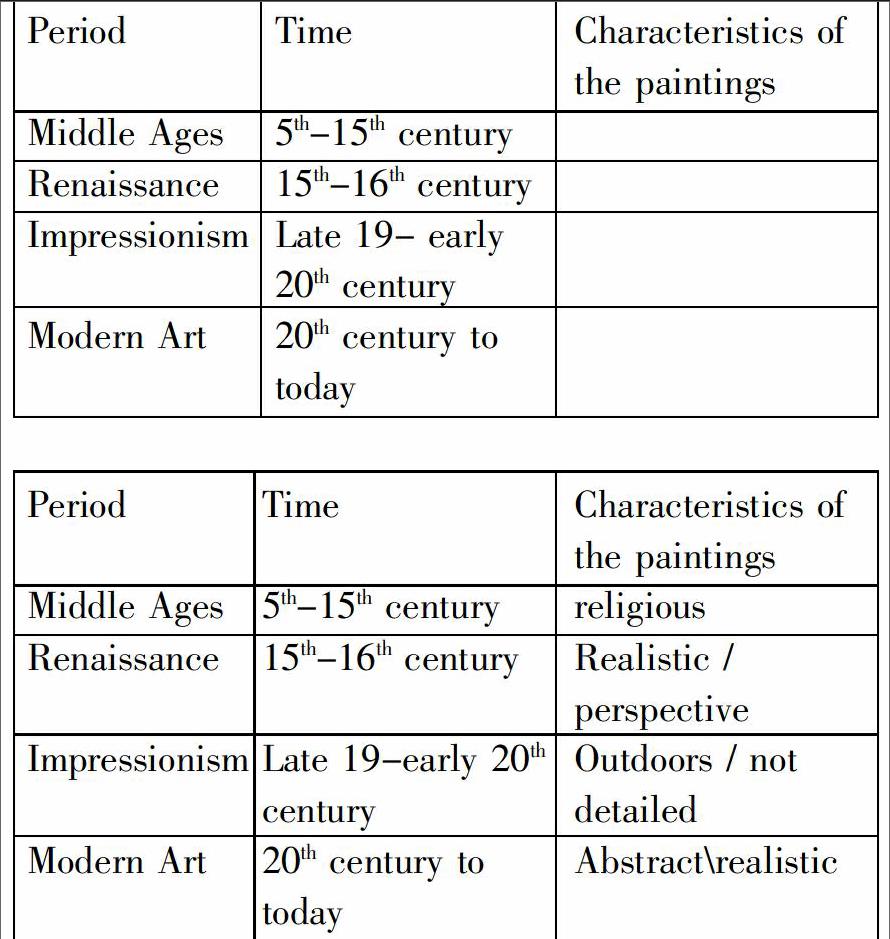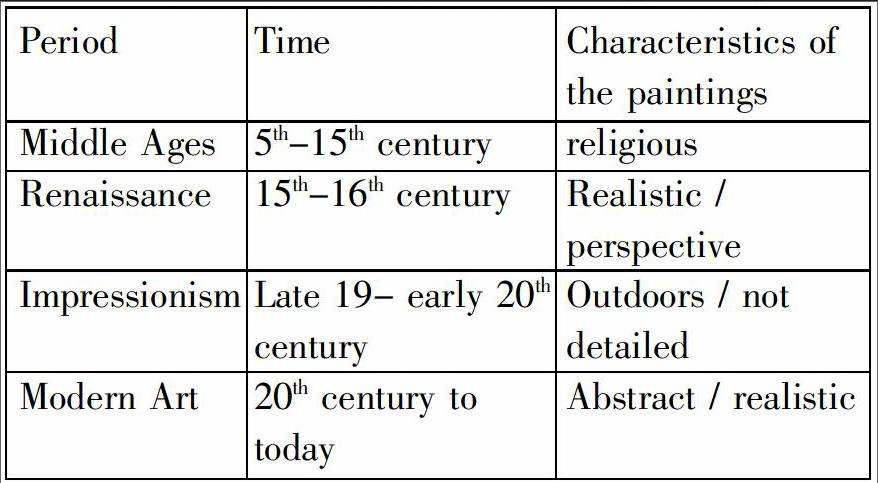董洁



【摘 要】 随着课堂改革的不断深入,课堂设计也不拘一格。然而,要真正提高课堂效率,课堂设计必须以凸显学生的主体地位,激发其学习兴趣和提高其学习积极性为目的。
【关键词】 teaching design
The following is my teaching design for a short history of western painting in Unit 1, Book 6, and New Senior English for China. The whole process is divided into five parts.
1. Teaching content analysis and it contains two points
Point 1 is knowledge background.
This is the second teaching period of this unit, and it mainly introduces the development of western painting. The first paragraph states the main factors that lead to the development of art, including customs and faith of a people. Then it introduces the five main streams of the western art. During the Middle Ages, the main aim of painters was to represent religious themes, which created a feeling of respect and love for God. During the Renaissance, people began to concentrate on a more humanistic attitude to life and drawing pictures in perspective was discovered by Masaccio. At the same time, oil paints were developed. In the late 19th century, the impressionists appeared and they work outdoors. Although their paintings were controversial, they were accepted as the beginning of what we call “modern art”, and realistic and abstract are their typical features. Four pictures, such as Abraham entertaining the angels, Like Barca and Leon the count, Sunrise impression,and The characters, are included in the text, which help to illustrate the different features of different periods directly.
The teaching emphasis will be put on developing students reading ability and getting them to learn to use some reading strategies, such as scanning, fast reading and careful reading. All the learning activities are closely related to the reading passage and aim to make students know about the development of art, its styles and features in different periods of times.
Point 2 is about difficult points in learning. We have two tasks in this part.
Task 1 is how to cultivate students reading ability. In this part, Ill arrange some exercises of different kinds, and adopt various reading methods, such as skimming, fast reading etc. to arouse students interest in learning English.
Task 2 is to develop students ability to obtain and process information, as well as the ability to analyze and solve problems.
2. Three dimensional learning goals and there are 3 points
Point 1 is about knowledge skills.
It aims to help the students develop their reading ability and learn to use some reading strategies such as scanning, fast reading careful reading and so on.
Point 2 is emotional attitudes and 3 tasks are included in this part.
Task 1 is to help students build up international consciousness, and intercultural communication competence.
Task 2 is to instruct students to be interested in learning, get self-confidence and learn to cooperate.
Task 3 is to educate students to love art, love life, and make them know the beauty of art is everywhere, including China. Thus we can strengthen students national pride.
Point 3 is about learning strategies and two tasks will be mentioned in this part.
Task 1 is communication strategy and it aims at improving the ability of communication.
Task 2 is resources strategy .It aims to make students know how to discover and enjoy art.
3. Learning methods and two points are referred to
Point 1 is task-based learning and students are asked to finish their assignments in the given time.
Point 2 is group work to discuss the topic. In order to form effective learning strategies, all the learning tasks and designs must be based on training students integrated skills. Personally, group cooperation and team exploration are the effective ways to cultivate students integrated language using ability
4. Specific teaching steps. Eight steps will be talked about here
Step 1 is lead in:
In order to arouse students interest, some videos and pictures of the famous art works, such as paintings by Leonardo da Vinci and Vincent van Gogh, will be designed for students. After watching the short videos, students will show great interest in learning about the development of western painting.
Step 2 is to present learning contents and target
Before learning, all the learning contents, goals, difficulties and learning methods will be presented to students so that they know their tasks of the whole period.
Step 3 is scanning and individual work
In this part, students will be asked to scan the text, and find the periods and the times mentioned in the reading passage. A kind of exercise called “Fill in the chart” will be arranged here, which prepares them for the further understanding of the reading passage.
Step 4 is fast reading and pair work
I will allow students several minutes to read the text fast and then work in pairs to complete the set questions, such as find the characteristics of the paintings in different periods. This activity helps to develop students ability to obtain and process information, and the ability to analyze and solve problems.

Step 5 is careful reading and group cooperation
Some exercises such as filling blanks according the reading text will be designed. Students are asked to read the passage carefully and finish the assigned tasks in groups and then present the results of their wok to the whole class. In this way, this activity can not only make students get some detailed information on the text, but also strengthen the deep understanding of the text and stimulate students learning enthusiasm. Some true or false questions will be arranged.
(1) Western art has changed very little over the last seventeen century.(F)
(2) Painters in the middle ages did not use perspective.(T)
(3) Impressionists painted landscapes.(T)
(4) You cannot recognize any object in abstract modern art.(T)
(5) In the Renaissance most artists painted indoors.(T)
(6) Abstract art is still an art style today.(T)
Step 6 is summarizing
After some repeated reading processes, students have had a better understanding of the history of western painting. And summarizing the major content of the text helps deepen the understanding of the text and make students well-prepared for their future study.
Step 7 is exercising and assessment
Different kinds of questions will be prepared for students, which encourages students to use what they have learnt in this period to analyze and solve problems. A certain amount of exercise helps students to develop their integrated skills and lay a good foundation for their further learning.
5. The design for the blackboard
The main idea of the text will be presented on the blackboard, so that students can have a clear understanding of the content of this class and can also further deepen the understanding of the content of this article.
The design for the blackboard.
[1] 张瑞娟. 初中英语课堂教学艺术[M]. 北京:中国林业出版社, 2005.
[2] 文秋芳. 英语学习策略论[M]. 上海: 上海外语教育出版社, 1996.
- 小议初中音乐课堂如何提高学生的鉴赏水平
- 广西乡村旅游发展研究
- 浅谈高中美术课堂教学效率提高的策略
- 邯郸成语典故文化旅游资源的开发探析
- 从内黄农民画的特点论其在现代新农村建设中的作用
- 湖南省发展露营旅游研究
- 论群文工作者一专多能的重要性
- 关于高职思想政治教育的观点
- 松潘县藏族村落旅游发展意愿研究
- 高中数学中养成良好学习习惯的方法初探
- 乡村旅游发展态势及对策
- 浅谈高校教学管理创新思考
- 吉林省体育旅游市场存在问题与对策研究
- 高中旅游地理中进行旅游发展的实施策略初探
- 试论“一带一路”背景下区域旅游发展协同路径
- 关于发展特色文化旅游业的思考
- 初中班主任提升管理工作效率方法分享
- 贵州省风景名胜区与农村城镇化的关系探析
- 小议高中政治课堂如何开展合作学习
- 贵州喀斯特地貌旅游开发研究
- 浅析我国刑事证人保护制度
- 古镇文化旅游可持续发展路径初探
- 浅谈中职校旅游服务与管理专业《园林植物欣赏》教学方法
- 开封市亲子农场旅游项目开发可行性研究
- 学好高中数学的方法初探
- reconcilable
- reconcile
- reconciled
- reconcilement
- reconcilements
- reconciler
- reconcilers
- reconciles
- reconcile yourself to sth
- reconciliation
- reconciliations
- reconciliation statement
- reconciliationstatement
- reconciling
- reconcilingly
- recondemn
- recondemnation
- recondemnations
- recondemned
- recondemning
- recondemns
- recondensation
- recondensations
- recondensed
- recondenses
- 赐借
- 赐假
- 赐允
- 赐光
- 赐册
- 赐函
- 赐剑
- 赐劳
- 赐勋
- 赐号
- 赐听
- 赐告
- 赐和
- 赐回
- 赐土封国
- 赐坐
- 赐墙及肩
- 赐墨
- 赐复
- 赐奠
- 赐姓
- 赐子千金,不如赐子一艺
- 赐存
- 赐宁守制
- 赐宴